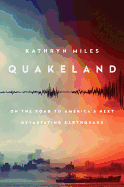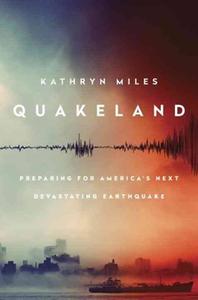
 Get ready. Don't live in San Francisco or Seattle? After reading Quakeland, the account of Kathryn Miles's trek across the United States in search of earthquakes, you'll realize there are fault lines all over.
Get ready. Don't live in San Francisco or Seattle? After reading Quakeland, the account of Kathryn Miles's trek across the United States in search of earthquakes, you'll realize there are fault lines all over.
Miles found that tectonic plates moving far below the earth's surface do not cause all quakes. Humans are responsible for much of the shaking by redistributing stress in rock, inducing tremors from oil and natural gas extraction, mining, building dams and reservoirs, wastewater injection, nuclear testing and even the construction of some high-rise buildings. In the first 40 years after completion of Hoover Dam, the waters of Lake Mead set off over 10,000 quakes. This happens with dams worldwide; ironically, the dams themselves perform well in earthquakes.
In Stillwater, Okla., tremors were first felt in 2006, when aggressive fracking began, followed by wastewater injection. Now the town gets 900 earthquakes a year. Many residents have taken to using plastic cups and plates because glass and china break. Every day, they hear claps, rumbles and booms. State geologists proved the connection between injection wells and tremors; the state ignored them, since its economy relies on oil, natural gas and wastewater storage.
As well as active zones in California and Alaska, there are active plates up and down the East Coast. A brittle grid underlies much of Manhattan; the Midwest has the New Madrid fault line. In Yellowstone, there are some 2,000 earthquakes annually. "Charting the seismic rising and falling of the Pacific Northwest is like playing Whack-a-Mole. Keeping track of Yellowstone is pretty much like playing the turbo version of that game--while you're drunk." According to the United States Geological Survey, more than 75 million Americans live in areas of significant seismic risk. On any given day, Earth experiences a thousand or so observable quakes. In the U.S., the aging infrastructure and lack of seismic retrofitting guarantees a major disaster at some point.
Faults, and their proliferation, keep surprising us--there is no known method for predicting earthquakes, nor is there likely to be one. Miles presents apocalyptic scenarios, but says, "We can create resiliency plans and policies that end in a very different scenario: one with far fewer lives lost." We should be in "permanent emergency" mode. Not just communities--everyone needs a plan: water and food for a week, a first-aid kit, a meeting place.
Miles covers the history of seismology and plate tectonics, and the passion, ingenuity and patience of seismologists and their cohorts. She considers past and recent quakes resulting from hundreds or thousands of years of accumulated energy, and quakes from recent fracking. Her descriptions of the earthquake plans of the Memphis airport and FedEx are fascinating, as is her research into Idaho's Lucky Friday silver mine and tsunami measures in Washington State. Quakeland is everything a popular science book should be: well-researched, anecdotal, sometimes humorous, and easily understood. --Marilyn Dahl
Shelf Talker: Travel across America with Kathryn Miles for a compelling story of fault lines, seismologists and the clear and present danger of earthquakes.

